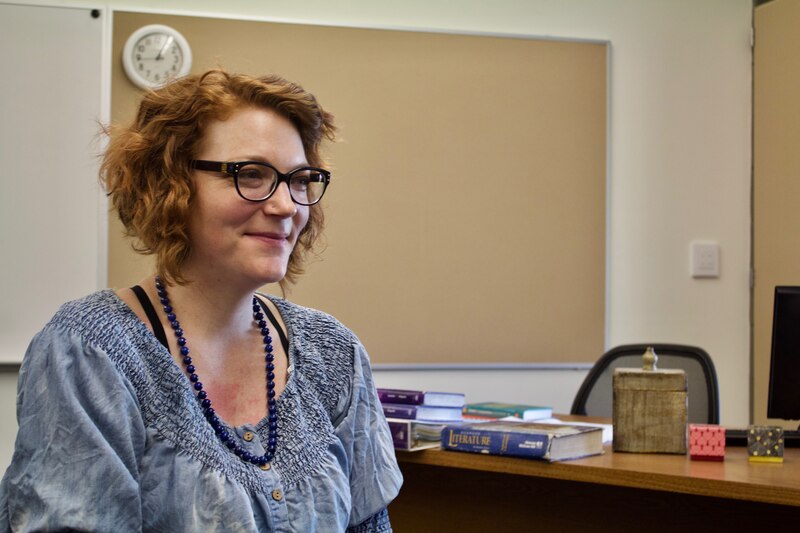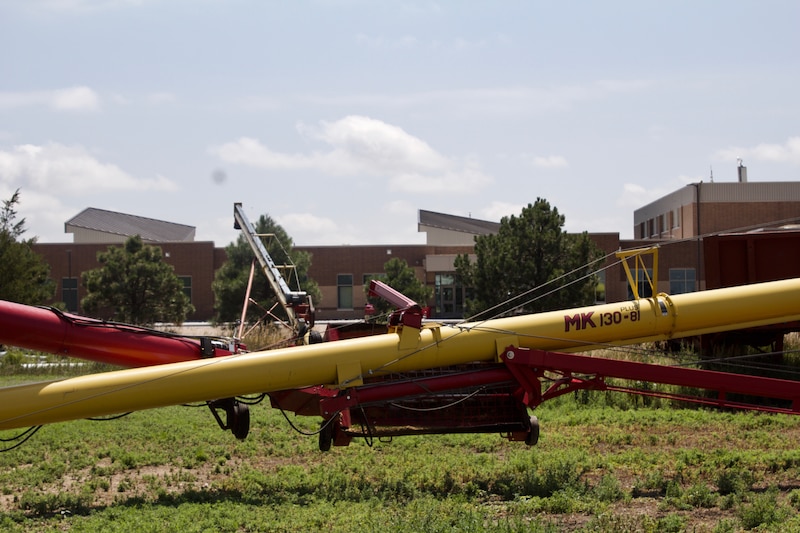OTIS — Late last spring, after five of her two dozen teachers resigned with no replacements in sight, Superintendent Kendra Anderson reassured her school’s anxious principal that everything would be fine.
Then she walked the 25 feet between their two offices, sat down at her desk and said to herself: “Oh, crap.”
Anderson remembered a time — and not that long ago — when she could pick out a six-year veteran from a pile of resumes whenever she had an unexpected teaching vacancy.
“I don’t have that luxury anymore,” she said this summer, recalling the desperate situation she was in to replace a fourth of the teaching staff of the rural K-12 school in just a few months.
Anderson’s urgent need for teachers for her 230 students — half of them living in poverty in this one-stoplight Colorado town on the Eastern Plains — offers a window into how rural schools like hers are grappling with a dearth of teachers.
Otis’s challenges to keep and attract teachers are felt across the state. Low taxes make it nearly impossible to offer a competitive salary; one retired Otis teacher suggested she could make more money waiting tables. Increased regulations and unfunded mandates from the state have made the work nearly unbearable, educators say. And the school’s distance from the Front Range keep some urban solutions such as long-term substitutes or Teach For America corps out of their classrooms.
On the ground, the biggest challenge for superintendents like Anderson is the need to protect students from the most damaging impacts of the shortage, even as many of them would benefit from more resources, not fewer.
“The one thing that keeps me up at night is how we go years with some of our rural schools not having a math teacher,” said Robert Mitchell, the former director of educator preparation at the department of higher education. “These kids out here deserve the same opportunity as the kids in Boulder Valley. It’s not acceptable that we have vacancies and zero people apply.”
The problem is so pronounced that state education officials, at the legislature’s behest, fanned out across Colorado this summer — including a stop in Otis — to examine ways to turn around a shortage that is most severe in the state’s rural areas.
A plan informed by this statewide tour, which was recently completed, is due to state legislators by December.

No overflow
“Everything has to change” whenever a teacher leaves, Michelle Patterson, Otis’s principal said. The ripple effects, especially in areas with small staffs, are significant.
When the school’s agriculture teacher left this spring, administrators had to find a new teacher to take over his class sponsorship duties, which included helping students raise money for projects and providing them with emotional support through high school.
No one knew which conferences to register the Future Farmers of America club for, or which hotels to stay at when they went.
The district also had to hire a new bus driver, because the retired teacher, a 21-year veteran, had done that, too.
“It’s more than just that instruction for that content area that leaves us,” Superintendent Anderson said. “It’s the relationship with the students they developed over time. It’s the training we’ve given them that’s lost.”
The teacher shortage is both an old and new problem for rural schools.
“We’ve had a teacher shortage in rural Colorado since the 1970s,” said Michelle Murphy, executive director of the Colorado Rural Schools Alliance. “But we used to be able to get overflow from the metro area. Now, there’s no overflow.”
Since 2010, there’s been a 24 percent drop in graduates from the traditional teacher prep programs at the state’s colleges and universities. There’s also been a 23 percent drop in enrollment to those programs.
Alternative programs, such as residency programs, have seen a 40 percent increase in enrollment. However, those programs produce far fewer teachers than traditional programs and can’t keep up with demand. According to the state department of education, the state’s public schools employ more than 53,000 teachers.
The shortage is not evenly distributed across all classrooms. Math and science teachers are in short supply: Only 192 college students in 2016 graduated with credentials to teach those subjects. The same year, 751 students left with a degree to teach elementary school.
Officials believe a variety of factors are contributing to the shortage. The profession perceives that it is undervalued, and the pay in many communities does not cover basic costs of living. And as poverty rises, the scope of the job is expanding; students are coming to school with more trauma that educators must mitigate before they can even begin to teach phonics or subtraction.
Rural schools face additional challenges attracting new teachers away from urban centers.
Housing is in short supply — so much so that some school districts are building their own housing for teachers.
And while the cost of living might seem lower in rural areas, “gas, groceries and health insurance all are more expensive,” Anderson said. “We travel a long way to the grocery store, to work. The nearest Walmart is 50 miles away.”
It can also be lonely, especially for recent college graduates without any family nearby.

A tale of two Otis teachers
Peggy Allen was one of the five Otis teachers to leave the classroom this spring.
Allen, who taught English, began her career in Otis as a secretary. After 17 years of running the school district’s office, she went to college to become a teacher.
“I loved teaching,” she said as she finished her lunch in Mama’s, Otis’s single restaurant, which also serves as its de facto town square. “You build a personal relationship with everyone at the school and in town. Everybody knows your business — and needs. We take care of each other.”
But after 12 years in the classroom, the 65-year-old decided to retire.
“I saw younger people with vigor and energy, and I thought: ‘I don’t have that anymore,’” she said.
Increased state regulations also became a burden. “I didn’t love jumping through all the hoops,” she said.
To find a replacement for Allen, Anderson reached out to a national network of principals and school officials she’s built through the years.
One woman who Anderson met at a conference several years ago had a daughter, Caitlin Evans, who had moved to a town 40 miles east of Otis. Evans, 33, had been teaching at Morgan Community College and was interested in switching to high schoolers.
Evans grew up in Brighton, a blue collar suburb of Denver. After high school, she enrolled at the University of Colorado. She remembers feeling far behind some of her fellow freshmen who attended East Coast prep schools.
Evans was excited about better preparing rural students for college to compete with their urban peers.
“If I can be a bridge for them, that’s a good thing,” she said.
But Evans had a newborn and no teaching license. So Anderson went to work helping her find childcare and working with state education officials to issue Evans an emergency license.
The state this year has issued 30 emergency licenses, which allow individuals to teach without meeting some state requirements.
State Rep. Jim Wilson, a Salida Republican, earlier this year sponsored a bill that would have allowed rural school districts like Otis to waive out of the state’s licensing practices all together. It was an idea that was backed by the Rural School Alliance but faced staunch opposition from the state’s teachers union. That opposition forced Wilson to spike his own bill.
Licensing reform, an issue that has vexed lawmakers and the governor alike, is likely to come up as the state education and higher education departments move forward with their plan to curb the shortage. But Superintendent Anderson is wary.
“I don’t want to give the perception that it’s easier to be a teacher than any other profession,” she said.
Otis school leaders were able to fill all of their vacancies, in part because Evans was issued an emergency license. However, it’s only good for one academic year. Anderson is already worrying about how to keep Evans in the classroom next year.

“We just need the resources”
More than 40 people showed up to the Otis school, which sits between a Baptist church and a corn, wheat and millet farm, for the state’s town hall on the teacher shortage.
In the audience were several members of the Otis community, including two school board members. There were executives from Denver-based education nonprofits. Educators from other Eastern Plains communities such as a principal from Julesburg and teachers from Yuma also attended.
State officials pleaded with the audience to focus on solutions — especially low-cost solutions. That doesn’t mean salary increases are off the table, the state officials said. It just means that everyone knows that teachers in the low tax state of Colorado could make a lot more money yet still trail far behind national average salaries.
This school year will be the first Otis teachers see a pay increase since the Great Recession. The starting salary will be $31,666. The average salary for an Otis teacher is $36,468, administrators said. And the highest paid teacher, a long time veteran, earns $46,258.
Part of the reason why the school district was able to afford the raises out of its $3.4 million budget was because of a rare savings in health care costs.
Anderson called it a gamble.
As the town hall began to wind down, Shea Smith, the Otis guidance counselor, snuck out and returned to her office, where she was preparing for the first day of school.
She and another teacher, Tenaly Bleak, reflected on the intersection of the teacher shortage and the changing demographics of their students.
As it becomes increasingly expensive to live along the Front Range, families are seeking low-cost housing on the plains. Since 2011, the school’s free or reduced-price lunch rate, a measure of poverty, has nearly doubled to 56 percent. Last year, the school enrolled its first homeless student. And there’s a good chance the school will need to hire a second special education teacher because a few new students with special needs enrolled this summer.
Smith, who has been in the Otis school for nine years, remembers the last time the school tried to hire a special education teacher. The job remained vacant for three years until the school’s leadership decided to take the job posting down and just do without.
As poverty has risen in Otis, teachers have taken on another role: caretaker.
“Somedays, the most you can do is love them and feed them and make them feel safe, and hope you can get a little reading in, and a little math in,” Smith said.
It’s unclear how student performance has shifted as poverty has increased in Otis. Poor students historically do not score as highly as their more affluent peers. Not enough Otis students are taking the state’s test for the state education department to report the results and provide a quality rating.
The role poverty is playing in the classroom and the stress it has put on educators has been highlighted by Education Commissioner Katy Anthes.
Teachers are reporting to the department that “they’re spending more time on management and organization and meeting the basic needs of students than they ever have before,” Anthes told the State Board of Education at its August meeting.
So what can the state do to keep teachers from fleeing Otis and other rural school districts?
Bleak said more support would go a long way. For instance, she suggested, establishing a special fund for school supplies and candy that teachers can hand out would save her $100 a month, she guessed.
“We care,” she said. “We want to do the best job possible. We just need the resources.”


